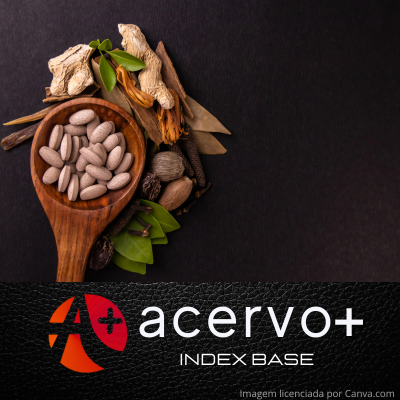O uso da fitoterapia no tratamento dos pacientes portadores de vitiligo
##plugins.themes.bootstrap3.article.main##
Resumo
Objetivo: Analisar a eficácia da fitoterapia no tratamento das pessoas portadoras de vitiligo e conhecer a importância do seu uso no tratamento da doença. Métodos: Trata-se de uma revisão integrativa, com artigos publicados entre os meses de agosto de 2024 a fevereiro de 2025, utilizando a base de dados PubMed, que pertence à U.S. National Institutes of Health's National, Scientific Electronic Library Online (SCIELO), o Google Acadêmico, Biblioteca Virtual em Saúde (BVS), plataforma que integra a Literatura Latino-Americana e do Caribe em Ciências da Saúde (LILACS) e Medical Literature Analysis and Retrievel System Online (MEDLINE), sendo a pergunta norteadora: A fitoterapia é uma terapia eficaz no manejo dos pacientes com vitiligo, utilizando a combinação dos Descritores em Ciências da Saúde Vitiligo AND Phytotherapy AND Treatment. Resultados: 20 artigos foram utilizados para compor a revisão, na qual o uso da fitoterapia se mostrou eficaz no tratamento dos pacientes com vitiligo. Considerações finais: Se faz necessário a elaboração de mais pesquisas sobre o uso da fitoterapia no vitiligo, uma vez que a temática ainda é escassa nos acervos, bem como é preciso destacar os benefícios dos compostos naturais e assegurar sua segurança e qualidade para a população.
##plugins.themes.bootstrap3.article.details##
Copyright © | Todos os direitos reservados.
A revista detém os direitos autorais exclusivos de publicação deste artigo nos termos da lei 9610/98.
Reprodução parcial
É livre o uso de partes do texto, figuras e questionário do artigo, sendo obrigatória a citação dos autores e revista.
Reprodução total
É expressamente proibida, devendo ser autorizada pela revista.
Referências
2. BRASIL MINISTÉRIO DA SAÚDE.2012.Práticas integrativas e complementares: plantas medicinais e fitoterapia na Atenção Básica. Normas e Manuais Técnicos–Caderno de Atenção Básica. Acesso em: 17 de janeiro de 2025.
3. CARLIE G, et al. KUVA (khellin plus ultraviolet A) stimulates proliferation and melanogenesis in normal human melanocytes and melanoma cells in vitro. British Journal of Dermatology, 2003; 149(4)
4. CESAR SCC, MIOT HA. Prevalence of vitiligo in Brazil-A population survey. Pigment Cell & Melanoma Research.2018;31(03)
5. CHEN Y, et al. Oral Chinese herbal medicine in combination with phototherapy for vitiligo: a systematic review and meta-analysis of randomized controlled trials. Complementary Therapies in Medicine, 2016.
6. COLUCCI R, et al. Evaluation of an oral supplement containing Phyllanthus emblica fruit extracts, vitamin E, and carotenoids in vitiligo treatment. Dermatologic therapy, 2015; 28(1)
7. DA CUNHA A. Aspectos históricos sobre plantas medicinais, seus constituintes activos e fitoterapia. 4ª ed. Lisboa: Fundação Calouste Gulbenkian, 2003.
8. DASTANGIR G, et al. Elemental, nutritional, phytochemical and biological evaluation of Hypericum perforatum. Linn. Pak J Pharm Sci. 2016; 29(2).
9. DE CASTRO C, et al. A pattern of association between clinical form of vitiligo and disease-related variables in a Brazilian population. Journal of Dermatological Science. 2012; 65(1)
10. DELLATORRE G, et al. Consenso sobre tratamento do vitiligo–Sociedade Brasileira de Dermatologia. Anais Brasileiros de Dermatologia (Portuguese), 2020.
11. EIBEL GSB, et al. Uso da infusão de folhas de Sonchus oleraceus para o tratamento de vitiligo. Research, Society and Development. 2021;10(4)
12. EZZEDINE K, et al. Vitiligo. Lancet. 2015.
13. GRIMES PE, BILLIPS M. Childhood vitiligo: clinical spectrum and therapeutic approaches. Vitiligo: a monograph on the basic and clinical science. 2000.
14. KHALEEL B, et al. Plants Used in the Treatement of Leucoderma by the Tribals of Yerramalai Forest of Kurnool District, Andhra Pradesh, India, J Ethnobiol TradMed. 2014
15. MACIEL MA, et al. Plantas medicinais: a necessidade de estudos multidisciplinares. Química nova. 2002; 25(3).
16. NESTOR, et al. Polypodium leucotomos as an Adjunct Treatment of Pigmentary Disorders. J Clin Aesthet Dermatol. 2014; 7(3)
17. NETO ATM, et al. Vitiligo: O problema que não está apenas na pele. Revista Interdisciplinar Pensamento Científico. 2015; 01(02).
18. PACIFICO A, et al. Combined treatment of narrowband ultraviolet B light (NBUVB) phototherapy and oral polypodium leucotomos extract versus NB UVB phototherapy alone in the treatment of patients with vitiligo. Journal of the American Academy of Dermatology. 2009;
19. PARSAD D, et al. Quality of life in patients with vitiligo. Health and quality of life outcomes, 2003.
20. REYES E, et al. Systemic immunomodulatory effects of Polypodium leucotomos as an adjuvant to PUVA therapy in generalized vitiligo: A pilot study. J Dermatol Sci. 2006;41(3)
21. ROCHA FGA, et al. O uso terapêutico da flora na história mundial. Holos. 2015.
22. SAAD B. Greco-Arab and Islamic herbal medicine: a review. 2014;04(03)
23. SHAFIEE A, et al. The effect of topical piperine combined with narrowband UVB on vitiligo treatment: A clinical trial study. Phytotherapy Research. 2018.
24. SHAKHBAZOVA A, et al. A systematic review of nutrition, supplement, and herbal-based adjunctive therapies for vitiligo. The Journal of Alternative and Complementary Medicine.2021;27(04).
25. SOCIEDADE BRASILEIRA DE DERMATOLOGIA. 2024. Vitiligo. Brasil. Disponível em: https://www.sbd.org.br/doencas/vitiligo/ Acesso em 18 de dezembro de 2024
26. STROH PA, et al. Plant atlas 2020: mapping changes in the distribution of the British and Irish flora. Princeton University Press. 2023.
27. SUN Y, et al. Randomized clinical trial of combined therapy with oral α‐lipoic acid and NB‐UVB for nonsegmental stable vitiligo. Dermatologic Therapy.2021;34(01)
28. TÓTH F, et al. Natural molecules and neuroprotection: kynurenic acid, pantethine and α-lipoic acid. International journal of molecular sciences. 2021;22(01)
29. WALKER, TD. The medicines trade in the Portuguese Atlantic world: acquisition and dissemination of healing knowledge from Brazil. Social history of medicine.2013;26(03)
30. XU P, et al. Effects of aqueous extracts of Ecliptae herba, Polygoni multiflori radix praeparata and Rehmanniae radix praeparata on melanogenesis and the migration of human melanocytes. Journal of Ethnopharmacology, 2017.

